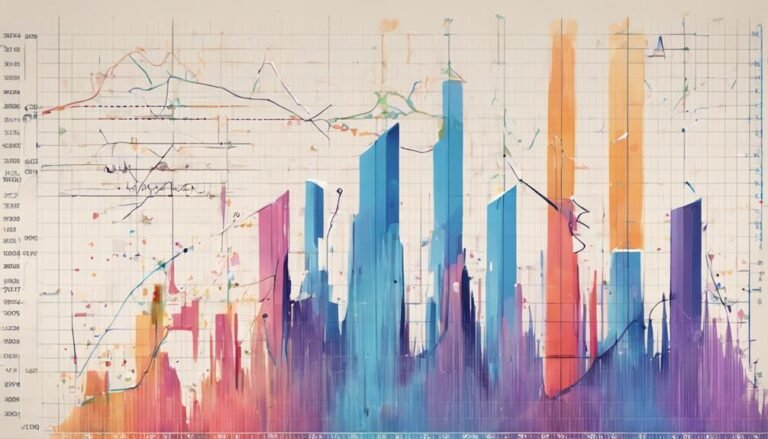Credit Risk Modeling
When it comes to traversing the financial landscape, analyzing credit risk is like deciphering a complex puzzle with high stakes. Imagine a scenario where every move you make must be calculated to guarantee a favorable outcome.
In the domain of Credit Risk Modeling, understanding the intricate web of data, statistical methods, and risk factors is paramount. As you explore deeper into this field, you'll discover the critical role it plays in safeguarding financial institutions and investors.
The strategies employed in Credit Risk Modeling are not just theoretical but hold practical implications that can shape the future of financial decision-making.
Key Takeaways
- Use statistical techniques and data analysis for accurate credit risk assessment.
- Consider economic conditions, industry trends, and regulatory changes for effective risk management.
- Minimize potential losses by optimizing credit scores and implementing robust risk mitigation strategies.
- Adopt machine learning, predictive modeling, and stress testing for enhanced credit risk modeling.
Importance of Credit Risk Modeling
Understanding the significance of credit risk modeling is essential for financial institutions aiming to make informed lending decisions. By employing risk mitigation strategies and credit scoring techniques, institutions can evaluate the creditworthiness of borrowers more accurately. Risk mitigation strategies involve identifying, evaluating, and prioritizing risks to minimize potential losses. These strategies help financial institutions anticipate and manage credit risks effectively.
Credit scoring techniques play a vital role in credit risk modeling by quantifying the creditworthiness of borrowers based on various factors such as credit history, income, and debt-to-income ratio. These techniques use statistical models to assign a numerical value, known as a credit score, to borrowers, indicating their likelihood of default. By utilizing advanced credit scoring techniques, financial institutions can streamline the lending process, reduce the risk of defaults, and optimize their overall loan portfolio performance.
Statistical Techniques in Credit Risk Assessment
When evaluating credit risk, statistical tools play an important role in analyzing risk factors. These techniques provide a data-driven approach to evaluating the likelihood of default or financial distress.
Statistical Tools for Assessment
What statistical techniques are commonly used in credit risk assessment to provide accurate and reliable insights into creditworthiness?
In credit risk modeling, model validation plays a critical role in evaluating the effectiveness of the developed models. It guarantees that the models are robust and reliable in predicting credit risk.
Predictive accuracy is another key factor, determining how well the model can forecast creditworthiness based on historical data.
Machine learning techniques are increasingly utilized in credit risk assessment due to their ability to handle complex data sets and identify patterns that traditional methods may miss.
Credit scoring, a fundamental statistical tool, assigns numerical scores to individuals based on their credit history, aiding in risk evaluation and decision-making processes.
Risk Factor Analysis
In examining Risk Factor Analysis within credit risk assessment, statistical techniques serve as important tools for evaluating the impact of various risk factors on creditworthiness. Risk factor identification is essential for understanding the drivers of credit risk in a portfolio. By analyzing historical data and employing advanced statistical models, institutions can enhance their default prediction capabilities and refine creditworthiness assessment.
Portfolio diversification is a key strategy derived from risk factor analysis, as it helps mitigate concentration risk and improve overall risk-adjusted returns. Through the application of statistical methods such as logistic regression or machine learning algorithms, financial institutions can gain deeper insights into the interplay between different risk factors and their influence on credit outcomes, ultimately aiding in more informed decision-making processes.
Data Analysis for Credit Risk Evaluation
Analyzing historical data plays a crucial role in evaluating credit risk accurately and effectively. By leveraging machine learning applications, financial institutions can sift through vast amounts of data to identify patterns and predict potential credit defaults. These applications can streamline the decision-making process by providing insights into customer behavior, payment patterns, and credit utilization.
In addition, portfolio management strategies are enhanced through data analysis. By examining historical performance data of various credit products, institutions can optimize their portfolio composition to minimize overall risk exposure. Understanding the relationship between different types of credit products and their risk profiles allows for a more diversified and resilient portfolio.
Data analysis not only aids in identifying high-risk borrowers but also in tailoring risk mitigation strategies for individual customers. By segmenting customers based on credit risk profiles derived from historical data, institutions can offer personalized credit terms and proactive support to mitigate potential defaults.
Factors Influencing Credit Risk
When analyzing credit risk, it's essential to explore various risk factors influencing the assessment. Factors such as credit scores play a significant role in determining an individual's creditworthiness.
Additionally, economic conditions must be thoroughly evaluated to gauge the overall risk exposure.
Risk Factors Analysis
What key factors greatly influence credit risk in financial institutions?
- Economic Conditions: Fluctuations in economic indicators such as GDP growth, unemployment rates, and interest rates can have a substantial impact on credit risk.
- Industry Trends: The performance of specific industries can affect credit risk. Industries experiencing growth may pose lower risks compared to those facing decline.
- Regulatory Environment: Changes in regulations, especially those related to lending practices and risk management, can have a direct influence on credit risk levels.
Analyzing these factors is important for effective risk management, default prediction, and portfolio optimization in financial institutions. By understanding and monitoring these variables, institutions can make informed decisions to mitigate credit risk and optimize their portfolios effectively.
Credit Score Impact
Understanding how credit scores impact credit risk in financial institutions is essential for effective risk management and decision-making processes. Two critical factors that profoundly influence credit risk are credit utilization and payment history. Credit utilization refers to the percentage of available credit being used by a borrower, with lower utilization generally indicating responsible financial behavior. On the other hand, payment history tracks whether borrowers make timely payments on their debts, showcasing their reliability. By analyzing these factors, financial institutions can assess the likelihood of borrowers defaulting on their loans. The table below illustrates how variations in credit utilization and payment history can affect credit risk:
| Factors | Impact on Credit Risk |
|---|---|
| Low Utilization | Decreases Risk |
| High Utilization | Increases Risk |
| On-time Payments | Decreases Risk |
| Late Payments | Increases Risk |
Economic Conditions Evaluation
Evaluating economic indicators and trends plays an important role in evaluating credit risk within financial institutions. Understanding macroeconomic indicators such as GDP growth, inflation rates, and unemployment levels provides insights into the overall health of the economy.
Industry trends, including sector-specific performance and regulatory changes, can also impact credit risk assessment. By analyzing these factors, financial institutions can better anticipate potential credit challenges and adjust their risk management strategies accordingly.
Monitoring macroeconomic indicators and staying informed about industry trends are essential practices for effectively managing credit risk exposure. Incorporating data-driven analysis of these economic conditions allows institutions to make more informed decisions and mitigate potential risks proactively.
Minimizing Potential Losses
To minimize potential losses in credit risk modeling, implement robust risk management strategies based on historical data analysis and predictive modeling techniques. Loss mitigation strategies play an important role in reducing credit risk exposure.
By utilizing advanced risk assessment techniques, such as default prediction models, you can identify high-risk borrowers and take proactive measures to mitigate potential losses. Portfolio optimization is another key aspect to take into account when aiming to minimize credit risk. Diversifying your portfolio across different types of assets and industries can help spread risk and reduce the impact of defaults on your overall portfolio performance.
Moreover, monitoring key risk indicators regularly and adjusting your risk management strategies accordingly is essential in minimizing potential losses. By staying informed about changing market conditions and adapting your approach in real-time, you can effectively navigate credit risk challenges. Remember, a proactive and data-driven approach is important in successfully minimizing potential losses in credit risk modeling.
Key Methodologies in Credit Risk Modeling
For a thorough approach to credit risk modeling, adopting key methodologies is essential to enhancing risk assessment accuracy and informing strategic decision-making. When it comes to credit risk modeling, incorporating advanced techniques such as machine learning can greatly improve predictive capabilities. Machine learning algorithms can analyze large datasets to identify complex patterns that traditional models may overlook, thereby enhancing risk evaluation.
In addition to machine learning, efficient portfolio management plays an important role in credit risk modeling. By diversifying credit exposures across various assets, industries, and regions, portfolio management helps mitigate overall risk. It allows for a balanced distribution of credit assets, reducing the impact of defaults on the portfolio.
Moreover, stress testing is an important methodology in credit risk modeling. Stress testing involves simulating adverse scenarios to evaluate the resilience of credit portfolios under different economic conditions. By stress testing portfolios, financial institutions can better prepare for potential risks and strengthen their risk management practices.
Conclusion
You've learned about the importance of credit risk modeling, statistical techniques, data analysis, factors influencing credit risk, and methodologies for minimizing potential losses.
By applying these key concepts and methodologies, you can make informed decisions to manage credit risk effectively. Remember, the more you understand about credit risk modeling, the better equipped you're to navigate potential risks and protect your financial interests.
Stay vigilant, stay informed, and stay ahead of the game.







